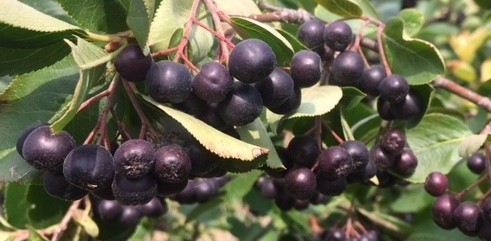Anthocyanins are Not Antioxidants
Recently someone asked me, “How do the colors in fruit keep me healthy?” So I used Google Scholar and read up.
Plants have compounds called “polyphenols” (the overall name) which give them their vibrant colors and can make them bitter, astringent, flavorful or delicious. They protect plants from damage from UV radiation, pathogens or things that would eat them. ALL plants provide us with an abundance of polyphenols (aka phytonutrients); there are over 500 chemical compounds in this category!
There are four types of polyphenols and one of them is “flavonoids.” Here’s two flavonoid names you might know: tannins and anthocyanins. You get flavonoids from fruits, vegetables, nuts, grains, spices, and drinks like juice, coffee, tea and wine. And let’s not forget chocolate. Basically, if a plant has darkly colored parts that we consume, like berries, it has a lot of healthful compounds.

Aronia berries have the highest known levels of polyphenols.
Do you remember “free radicals”? These are forms of oxygen that damage our cells. They’re missing an electron and they try to steal one from another molecule so that they can be complete. But once they steal that electron, the place they got it from needs to do the same thing from somewhere else. This just keeps going on and on until an “antioxidant” puts a stop to it. Antioxidants can give up an electron and not care about it. They are confident molecules! Vitamin C and uric acid are potent antioxidants.
On websites and older science papers, you will read over and over that polyphenols, flavonoids, tannins, anthocyanins, etc – are antioxidants. They act that way in test tubes in a lab but in the body, they do not. Eating food high in flavonoids is still super healthy for you but just not in the way we are led to believe.
More recent research tells us that after you eat fruits and vegetables, only a tiny percentage of colorful flavonoids are absorbed while the rest are rapidly metabolized and excreted. Our body sees them as foreign and is trying to get rid of them. What actually happens is that the flavonoids stimulate other pathways that are the real antioxidants: uric acid levels increase and nitric oxide synthase is activated. Flavonoids also appear to strongly influence cell signaling pathways and gene expression, with relevance to both cancer and heart disease.1
In conclusion, eat a mix of colorful berries (and other fruits, vegetables, nuts and grains) so that you consume different polyphenols. They are not actual antioxidants but they tell the body’s real antioxidants to go do their jobs.
- Studies Force New View on Biology, Nutritional Action of Flavonoids www.eurekalert.org/pub_releases/2007-03/osu-sfn030507.php
Kathy Wiederholt
Fruit Project Manager
Kathy.Wiederholt@ndsu.edu


